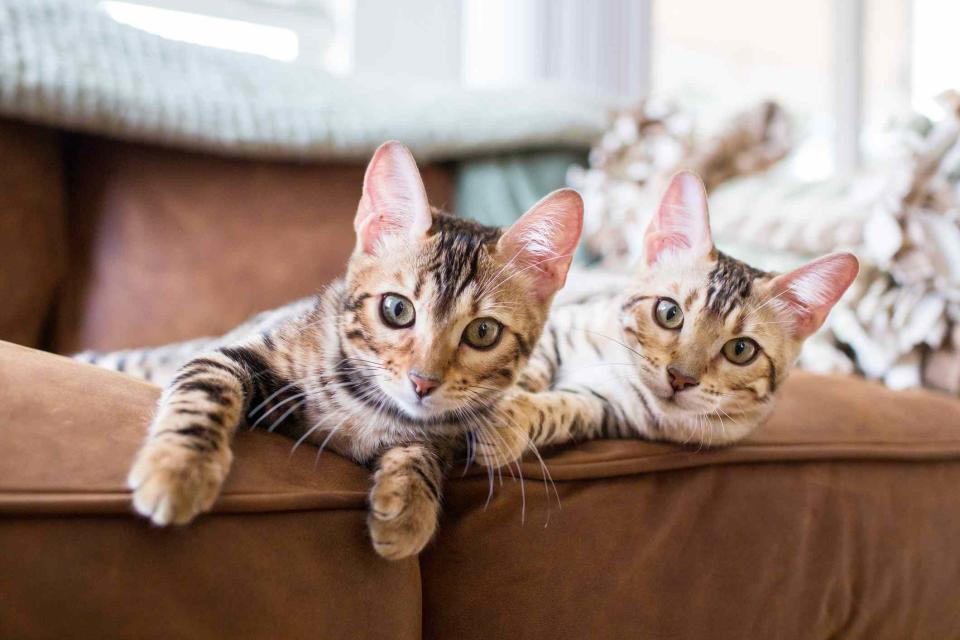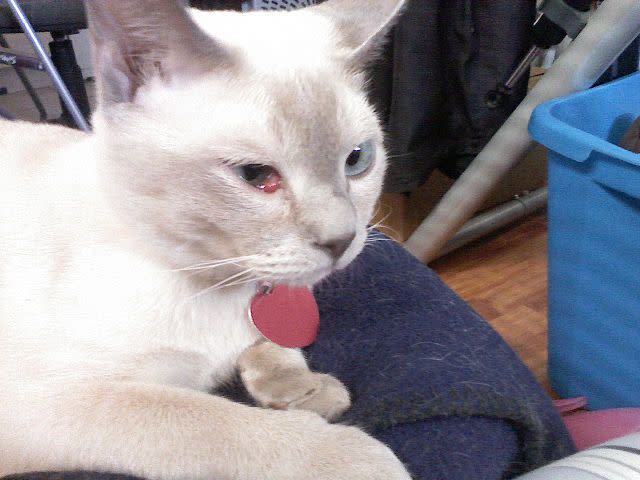Cherry Eye in Cats
Causes, Treatment, and Prevention

Cherry eye in cats happens when the third eyelid becomes inflamed and red, resembling a small cherry. This is more than just a cosmetic issue and can cause irritation and discomfort. Here's what pet parents should know about cherry eye in cats.
What Is Cherry Eye in Cats?
Cherry eye in cats is the protrusion of the third eyelid that swells and reddens into a visible "blob" of tissue along the edge of the eye. The third eyelid is the innermost layer of eyelid tissue that helps protect and lubricate a cat's eye. When functioning properly, it's rarely seen because it is tucked against the corner of the eye socket.
The medical term for cherry eye is "prolapsed nictitating membrane." It's also seen in dogs and rabbits. Humans lack a third eyelid, so we cannot develop cherry eye.
Cats and Their Very Unique Eyes
Symptoms of Cherry Eye in Cats
The primary sign of cherry eye in cats is a pink or red fleshy protrusion coming from the inner corner of a cat's eye. It's often described as a pink bubble or swelling and may be large enough to block part of a cat's eye. Cherry eye may come and go or be present consistently.
Cherry eye can be uncomfortable for some cats, leading them to paw at the eye or rub their face on surfaces. The eye may not be properly lubricated with a non-functional third eyelid, and friction can cause irritation, infections, and corneal ulcers. A corneal ulcer is very painful and can lead to permanent eye damage.

What Causes Cherry Eye in Cats
Cherry eye occurs when the fibers that hold the third eyelid in place become weakened or damaged. The membrane and the tear gland within it become swollen and protrude from the eye. Several things can cause this:
Anatomy: Brachycephalic (flat-faced) cats like Persians are more susceptible to cherry eye because their large, protruding eyes may crowd the eye sockets or weaken the connective tissues in the third eyelid.
Foreign particles: Dirt, grass, or other materials may get caught in the eye and cause irritation.
Weak retinaculum: The retinaculum stabilizes the tendons that help hold the third eyelid in place. Sometimes, it is weak from birth or becomes too weak to do its job, so the membrane pops out.
How Vets Diagnose Cherry Eye in Cats
Cherry eye is very recognizable by a veterinarian. Once the condition is identified, the vet will look for an underlying cause. They will closely examine your cat's eye to check for injuries or foreign particulate matter.
How to Know When to Call the Vet for Your Cat
How to Treat Cherry Eye in Cats
Depending on the severity of the cherry eye, treatment may not be necessary. Some cherry eyes will come and go on their own while others will pop out and stay out.
Your vet may carefully tuck the membrane back into the eye socket by applying gentle pressure on the gland. However, this is often a temporary fix as the third eyelid will often protrude again.
Eye Medications
The vet may recommend lubricating eye drops to protect and moisturize the eye. If secondary problems have developed due to a cherry eye, ophthalmic ointments or eye drops may be necessary.
Surgery
When cherry eye is chronic or causes other problems, vets recommend corrective surgery. One approach is to stitch the gland back into place to allow the inflammation to subside so that the membrane can resume lubricating the eye. In other cases, the gland will be removed if it is no longer serving its function of providing tears to the eye.
Prognosis for Cats with Cherry Eye
Cherry eye isn't typically a critical condition, but chronic cases indicate an inflammatory issue with the eye that will require treatment to resolve. The worst-case scenario is loss of vision due to severe corneal scarring, but this is a rare occurrence.
Most cats recover well from cherry eye surgery with proper home care. Be sure your cat wears a cone or e-collar alternative to prevent rubbing at the eye. Give medications as directed and follow up with your vet regularly.
How to Prevent Cherry Eye in Cats
Unfortunately, there is no reliable way to prevent cherry eye in cats. If a cat is born with a weak retinaculum or a small eye socket, there is nothing you can do to prevent a cherry eye from happening. You can, however, be vigilant about making sure your cat's eyes do not get too dry by using eye drops as recommended by your vet. Early detection can simplify treatment, so contact your vet at the first sign of an eye problem and visit the vet for routine wellness checkups.
Read Next: How Often Should Your Cat Go to the Vet?
Read the original article on The Spruce Pets.

